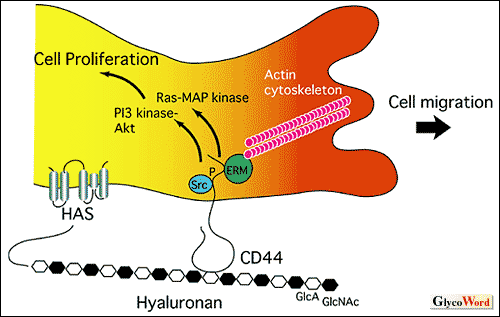Naoki Itano
Institute for Molecular Science of Medicine, Aichi Medical University
Qualitative and quantitative changes are frequently observed in the extracellular matrix composing cancer stroma. In particular, a high level of hyaluronan, a major sugar component of the extracellular matrix, is often associated with malignant progression in many cancers such as breast cancer, colorectal cancer, and glioma. An enormous increase in the hyaluronan synthesis is also induced during malignant cell transformation caused by oncogenic viral infection. Recently, we have elucidated the mechanisms by which oncogene products elevate the expression of the hyaluronan synthetase (HAS) genes, leading to increased synthesis of hyaluronan 1. Due to overproduction, cancer cells form a hyaluronan-rich matrix, which is considered to promote tumor growth, invasion, and metastasis. Indeed, when increased levels of hyaluronan production and matrix formation were experimentally induced by overexpression of HAS genes, tumor growth of fibrosarcoma cells and metastatic ability of breast cancer cells were stimulated 2,3.
To detach themselves from the primary tumor, invade the surrounding tissue, and form metastatic lesions, cancer cells need to acquire motility and reconstruct a pericellular environment suitable for cell movement. Hyaluronan is assumed to enhance cancer cell invasion by stimulating cell migratory activity, and the molecular basis of the effects has been rapidly elucidated (Fig. 1). For example, exposure of hyaluronan to the cancer cells activates various intracellular signaling cascades such as PI-3 kinases, c-Src, FAK, and MAP kinases, via its receptors CD44 and RHAMM (receptor for hyaluronic acid-mediated motility). These in turn induce cytoskeletal rearrangement and membrane ruffling, leading to active cell migration.

Fig.1 Activation of intracellular signaling molecules and cytoskeletal rearrangement by hyaluronan stimulation.
Hyaluronan, which is synthesized by hyaluronan synthases, induces the activation of intracellular signaling molecules and cytoskeletal rearrangement via hyaluronan receptors such as CD44 and RHAMM.
ERM: ERM (ezrin-radixin-moesin) family
The development of tumor vessels is a key step in promotion of tumor growth and metastasis of cancer cells to distant sites. Since hyaluronan oligosaccharides promote “angiogenesis,” the accumulation of the oligosaccharides in tumor tissues is considered to be a risk factor for cancer progression. A new therapeutic strategy to target the HAS molecules is promising as an attempt to inhibit cancer invasion and metastasis.